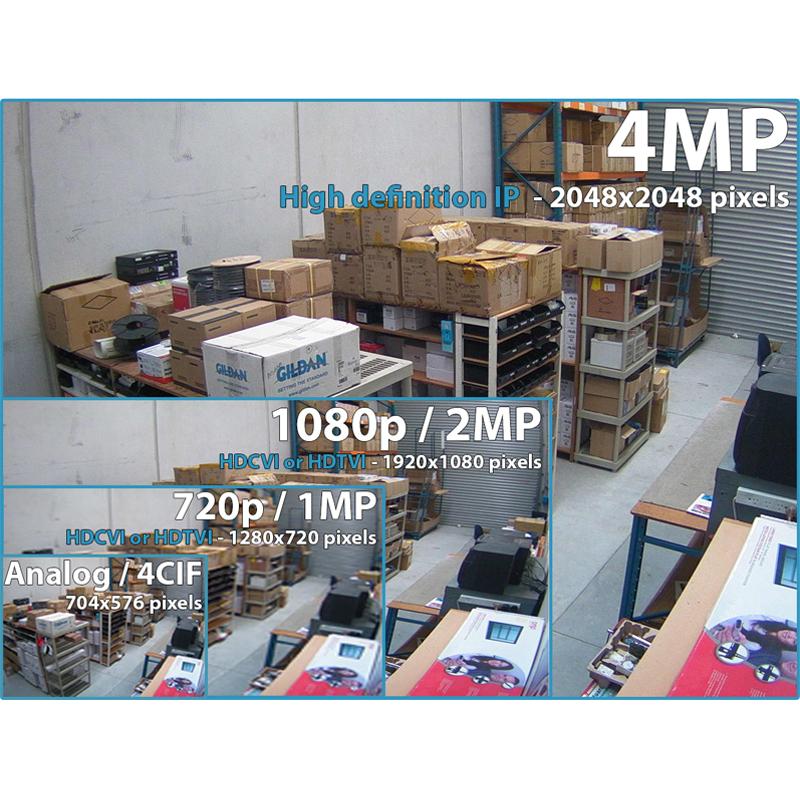The quality of the picture captured from an HD security cameras is probably the single biggest advantage IP CCTV systems have when compared with traditional analog systems.
Megapixel resolution uses a megapixel sensor to deliver an image with one million or more pixels. The more pixels the image has, the greater detail it captures, producing a higher quality image. Being able to see more detail in the picture means there is more potential to identify people and objects or to view a larger area of a scene. This benefit is an important consideration with surveillance systems.
The maximum resolution that an analog surveillance system can provide is D1 resolution. The most commonly used is 4CIF which has a resolution of 704X576 pixels or 0.4 megapixel. In comparison a low megapixel format of 1280X1024 pixels gives a 1.3 megapixel resolution which is more than three times the resolution of a good analogue system. IP or megapixel cameras can go up to 8 megapixel already and our most popular model is a 4MP IP camera.
Due to the way video is transmitted and stored on the NVR in an IP security camera system there is no loss in picture quality between what is seen “live” from the camera and what is seen when playing back the recorded image. IP CCTV cameras are also less prone to picture interference as the transmitted video is in IP or digital format rather than an analog signal in a conventional CCTV system. Analog security cameras send their video signal over a coax cable or twisted pair of copper cables. If these cables are close to a mains electrical cable such as power or lighting, or pass close to “noisy” electrical devices such as extractor fans or machinery the video signal can be affected as the signal voltage is only around 1v.
So what does that mean for a CCTV image captured on a IP security camera?
The image below shows the difference in picture quality between analog (CIF and 4CIF) and IP (1.3 and 3 MP) security cameras looking at the same workshop view. Not only are the IP images much bigger but the level of detail they capture is much higher. Note the difference in clarity between the CIF and 1.3 MP in the yellow callout boxes which show a zoomed-in view of part of the image.
So how will an HD image be an advantage in a practical scenario?
Imagine there is a query on who picked up a parcel from your workshop. You go back to through the surveillance footage history and find the point in time when the parcel in question was collected. You take a still from the image and then paste it onto a piece of paper and print it out to try and identify the people involved.
Below are two possible scenarios for what information those still images will provide. The first image is captured on a high resolution analog CCTV camera recording to a 4CIF DVR. The second is captured by a 3MP IP camera recording to an NVR. Note that we have pasted each image at pixel size onto an A4 sized piece of paper to give you an idea of the size of the image. We then expanded each image to to the edges of the piece of paper to show more of the resolution detail.


It is likely the staff member can be identified because you know them. But unless you knew the person who collected the package you would probably not be able to identify them from the 4CIF image whereas the 3 MP image gives good clarity at both pixel size and when zoomed in. This would greatly enhance the possibility of a possible identification being made.
The 3MP image is a lot bigger even at pixel size and when expanded to fill the piece of paper it retains clarity and detail. In comparison the 4CIF image provides minimal detail and a much smaller image.
And as an aside, many higher end NVRs also offer far better search and playback functionality than a DVR. When searching to find this image in your history you could have simply drawn a box around the parcel and the NVR would automatically search out all files relating to movement of that parcel. With the DVR you can search for movement on that camera but cannot narrow it down to a specific area on the screen. If you have a busy warehouse there could be many hours of irrelevant footage to look through before you find the specific event you are looking for.
Picture quality and clarity is such an important consideration when choosing what technology to use with your surveillance system. If you are monitoring a busy retail environment, a restaurant or bar, a till or reception desk where money changes hands, or any environment where you want to identify people and objects, megapixel CCTV technology can greatly enhance the ability to make a positive identification. Imagine the frustration of recording a shop lifter or burglar but not having enough detail to identify them or recording a vehicle used to rob your premises but not being able to read the registration plate.
While IP camera systems tend to be more expensive than analog systems you must decide whether purchasing the lower quality system is going to do the job for you. We sell both types and are happy to show you actual images from different camera options and resolution levels.


